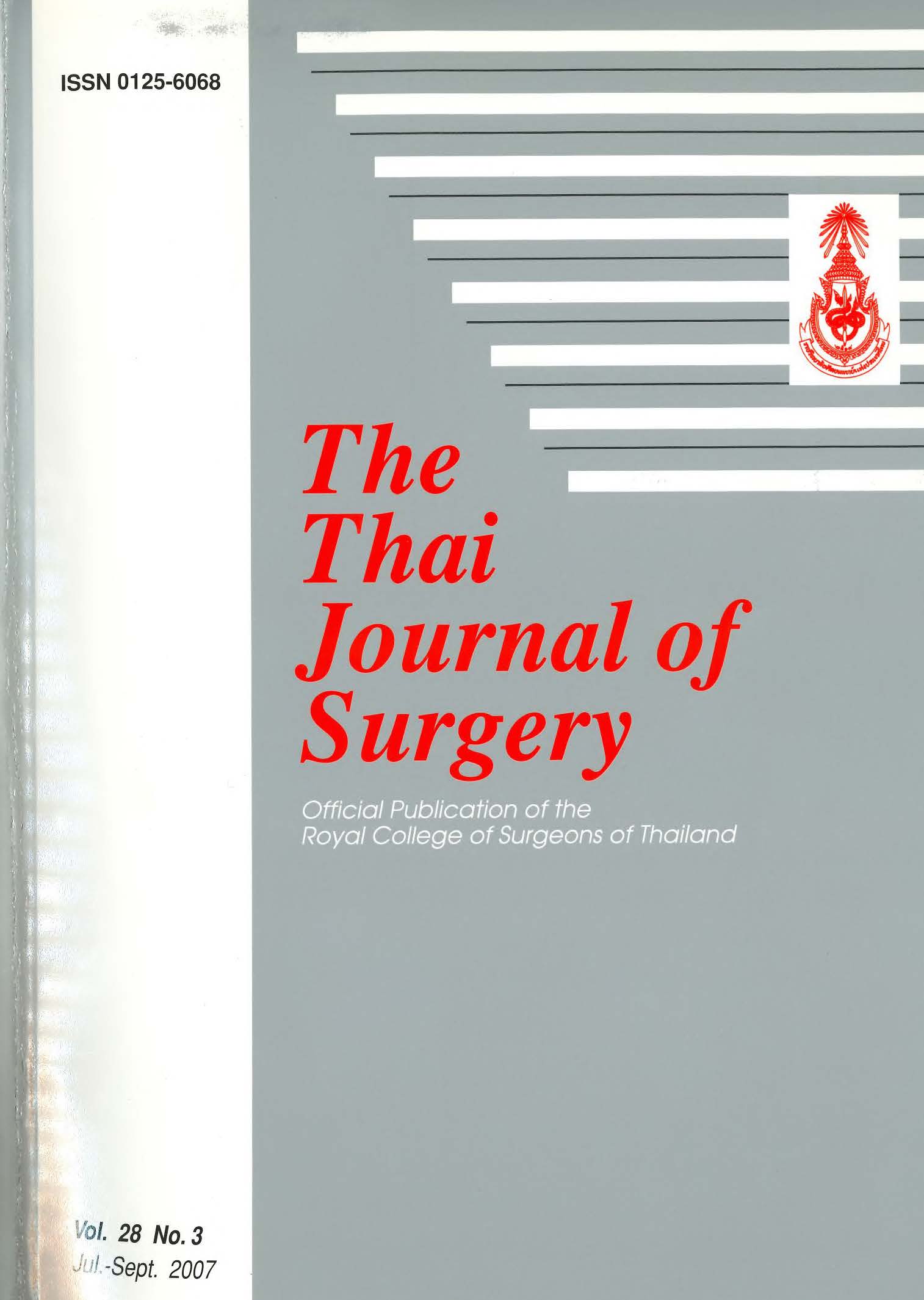Advantages of Urgotul S,.S.D over Silver Sulfadiazine Cream in the Outpatient Management of Partial Thickness Burns
Keywords:
Silver sulfadiazine, Urgotul SSDTM, burn wound, wound infectionAbstract
Introduction: Topical application of silver sulfadiazine has been used in the treatment of partial thickness burns for many years, Pain during daily wound cleansing is the main problem. Urgotul SSD,TM a hydrocolloid dressing with silver sulfadiazine (SSD) has been reported to reduce infection and exhibit antimicrobial activity in burn wounds.
Objectives: The purpose of this study was to compare the efficacy of Urgotul SSDTM and 1% silver sulfadiazine for the treatment of partial thickness burn wounds.
Materials and Methods: We reviewed 70 patients who had partial thickness burn wound less than 15% total body surface area (TBSA%) and were treated at Siriraj out-patient burn clinic during July 2005-December 2006. All patients were divided into two groups: Urgotul SSDTM treated group (35 patients) and 1% silver sulfadiazine treated group (35 patients). Two patients were excluded; one was due to allergic reaction to silver sulfadiazine and another one in Urgotul SSDTM treated group was pregnant. The two groups were compared by the demographic data including age, gender, % total body surface area (TBSA) burn, % TBSA deep burn, as well as percent of wound infection, total cost of wound dressing, pain medication, level of pain and time of wound healing. There were no differences in demographic data of age, % TBSA burn, % wound infection and total treatment cost of burn wound care (US$ 52 ± 38 for Urgotul SSDTM versus US$ 45 ± 34 for silver sulfadiazine treated group),
Results: Time of wound closure was significantly shorter in Urgotul SSDTM treated group (10 ± 4 days in Urgotul SSDTM versus 12 ± 6 in 1% silver sulfadiazine treated group, p <0.05). Average pain scores and pain medication in Urgotul SSDTM treated group were significantly lower than in 1% silver sulfadiazine treated group (3 ± 1 versus 6 ± 2 respectively, p <0.05). All of the patients who developed wound infection responded well to targeted topical and oral antibiotic treatment.
Conclusions: We conclude that Urgotul SSDTM has advantages of reducing pain symptom, pain medication requirement, increased patient convenience due to decreased time of follow-up at out-patient burn clinic, limiting the frequency of replacement of the dressing at comparable total cost and incidence of burn wound infection. This study confirms the efficacy of Urgotul SSDTM in the treatment of partial thickness burn wound at out-patient clinic.
References
2. Gerding RL, Emerman CL, Effron D, Lukens T, Imbembo AL, Fratianne RB, Outpatient management of partial-thickness burns: Biobrane versus 1% silver sulfadiazine. Ann Emerg Med 1990;19:121-4.
3. Muangman P, Chuntrasakul C, Silthram S, et al. Comparison of efficacy of 1% silver sulfadiazine and Acticoat for treatment of partial-thickness burn wounds. J Med Assoc Thai 2006;89(7):953-8
4. Carsin H, Wassermann D, Pannier M, Dumas R, Bohbot S. A silver sulphadiazine-impregnated lipidocolloid wound dressing to treat second-degree burns. Journal of Wound Care 2004:13(4):145-8.
5. Benbow M, losson G. A clinical evaluation of Urgotul to treat acute and chronic wounds. Br J Nurs. 2004;13(2):105-9.
6. Blanchet-Bardon C, Bohbot S. Using Urgotul dressing for the management of epidermolysis bullosa skin lesions. J Wound Care 2005;14(10):490-6.
7. Meaume S, Senet P, Dumas R. Urgotul®: a novel non- adherent lipido-colloid dressing. (Results of first clinical trial). Brit J Nursing 2002;11(16):42-50.
8. Demling RH. Use of Biobrane in management of scalds. J Burn Care Rehabil 1995:16:329-30.
9. Benbow M. Urgotul® : alternative to conventional non-adherence dressings. Brit J Nursing 2002;1 1(2):135-8.
10. Bernard FX, Barrault C, Juchaux F, Laurensou C, Apert L. Stimulation of the proliferation of human dermal fibroblasts in vitro by a lipidocolloid dressing. J Wound Care 2005;5 (14):215-20.
11. Meaume S, Ourabah Z, Cartier H, et al. Evaluation of a lipidocolloid wound dressing in the local management of leg ulcers. J Wound Care 2005;14(7):329-34.
12. Phillips LG, Robson MC, Smith DJ. Uses and abuses of a biosynthetic dressing for partial-skin thickness burns. Burns 1989;15(4):254-6.
13. Bauman LW, Hawkins ML, Howdieshell TR, Till AH, Treat RC. Bilaminate synthetic dressing for partial thickness burns: Lack of cost reduction for inpatient care. Am Surg 1991;57(3):131-3.
14. Klein RL, Rothmann BF, Marshall R. Biobrane: A useful adjunct in the therapy of outpatient burns. J Pediatr Surg 1984;19:846-7.
15. Mozingo DW, McManus AT, Kim SH, Pruitt BA. Incidence of bacteremia after burn wound manipulation in the early postburn period. J Trauma 1997;42(6):1006-10.
16. Ou LF, Lee SY, Chen YC, Yang RS, Tang YW. Use of Biobrane in pediatric scald burns: Experience in 106 children. Burns 1998;24:49-53.
Downloads
Published
How to Cite
Issue
Section
License
Articles must be contributed solely to The Thai Journal of Surgery and when published become the property of the Royal College of Surgeons of Thailand. The Royal College of Surgeons of Thailand reserves copyright on all published materials and such materials may not be reproduced in any form without the written permission.



